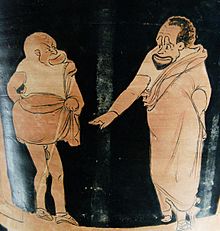Sicilian vase painting


The Sicilian vase painting was a regional style of the lower Italian - red figure vase painting . It was one of the five sub-Italian regional styles. Together with the Lukan and Paestan vase painting , it formed a closer stylistic community.
The beginning of Sicilian vase painting is still in the dark today. The production of Sicilian vases began before the end of the 5th century BC. In the cities of Himera and Syracuse . The workshops based their work on the Attic models in terms of style, theme, ornaments and vase shapes. Above all, the influence of the Attic-late classical Meidias painter is recognizable. It is possible that the first potters and painters were Athenian prisoners of war. The chessboard painter , one of the first Sicilian vase painters, seems to have been trained by the Attic Pothos painter . His student, the Dirke painter , established the typical Sicilian way of working. In the second quarter of the 4th century BC Ceramists who emigrated from Sicily to Capua and Cumae in Campania and Paestum established the production facilities there, and only in Syracuse a limited vase production remained.
The typical Sicilian vase painting was only created around 340 BC. We can distinguish three workshop groups. A first group, called Lentini-Manfria , was active in Syracuse and Gela , a second group on Etna ( Centuripe genus ) and the third group on Lipari . The tone of the vases is pale pink, the black paint is a dull shade, it peels off easily. The use of additional colors, especially white, is particularly typical of Sicilian vase painting. Especially in the early stages of large vessels such as were calyx krater , Volutenkratere and hydriai painted, but smaller vessels such as bottles, are Lekanen , lekythoi and skyphoide pyxides typical. Above all, scenes from the world of women, erotes, women's heads and phlyacs are shown . Mythical content is rare. As in all other areas, around 300 BC marks the year. The end of Sicilian vase painting.
The Sicilian vase painting was recognized relatively late. Around 1,000 vases are now known.
literature
- Arthur D. Trendall : The red-figured vases of Lucania, Campania and Sicily. 2 volumes. Clarendon Press, Oxford 1967.
- Arthur D. Trendall: The red-figured vases of Lucania, Campania and Sicily. (= University of London. Institute of Classical Studies. Bulletin. Supplement. Vol. 41) Supplement 3. University of London - Institute of Classical Studies, London 1983, ISBN 0-900587-44-X .
- Arthur D. Trendall: Red-figure vases from southern Italy and Sicily. A manual (= cultural history of the ancient world . Vol. 47). von Zabern, Mainz 1991 ISBN 3-8053-1111-7 , especially pp. 36–38, 265–289.
- Rolf Hurschmann : Sicilian vases. In: The New Pauly (DNP). Volume 11, Metzler, Stuttgart 2001, ISBN 3-476-01481-9 , column 606 f.
- Thomas Mannack : Greek vase painting. An introduction. Theiss, Stuttgart 2002, ISBN 3-8062-1743-2 , pp. 164-165.